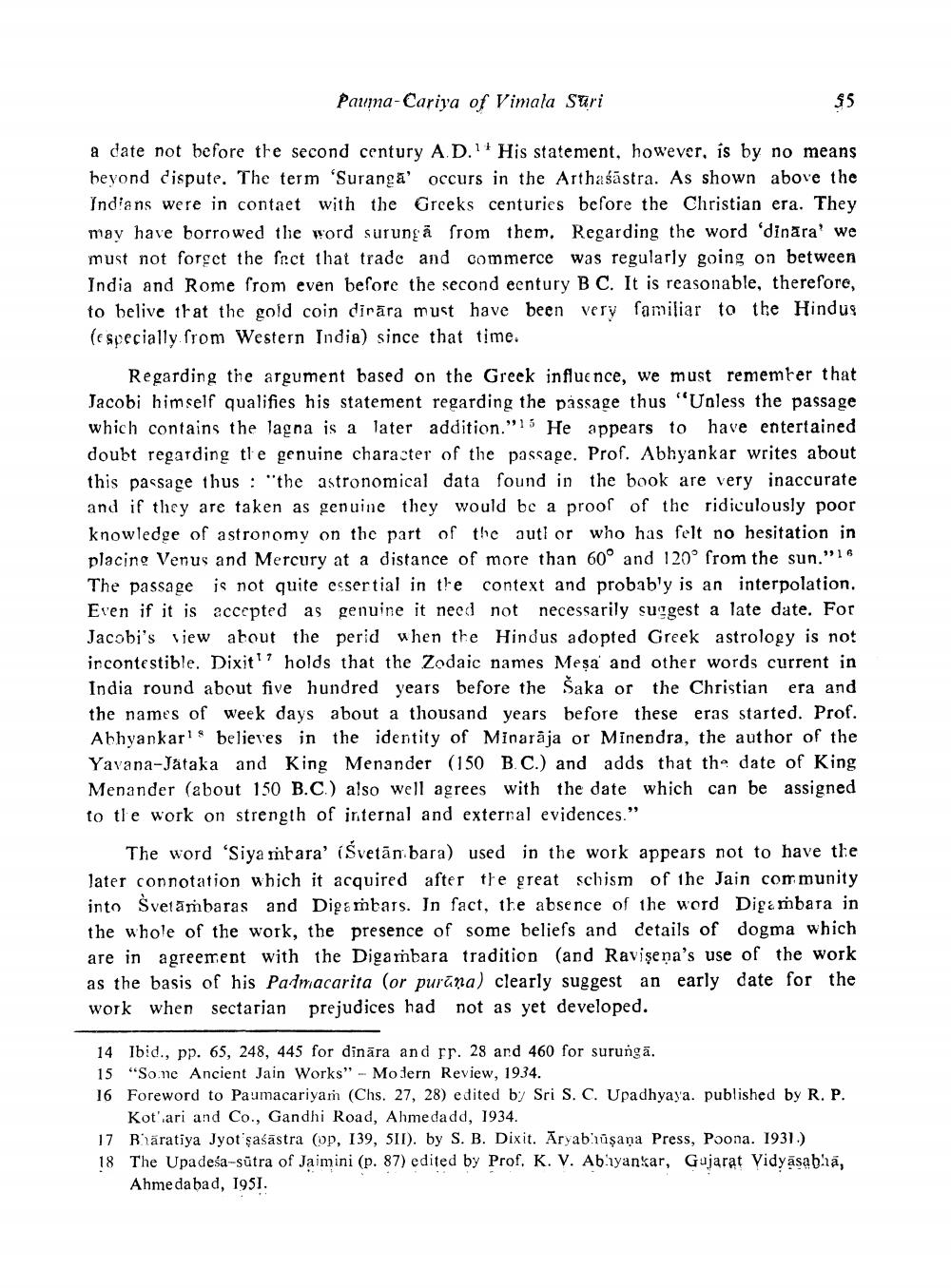________________
Pauma-Cariya of Vimala Suri
a date not before the second century A.D. 1. His statement, however, is by no means beyond dispute. The term 'Suranga' occurs in the Arthaśāstra. As shown above the Indians were in contaet with the Greeks centuries before the Christian era. They may have borrowed the word surungă from them. Regarding the word 'dinara' we must not forget the fact that trade and commerce was regularly going on between India and Rome from even before the second century BC. It is reasonable, therefore, to belive that the gold coin dirāra must have been very familiar to the Hindus (especially from Western India) since that time.
Regarding the argument based on the Greek influence, we must rememter that Jacobi himself qualifies his statement regarding the passage thus "Unless the passage which contains the lagna is a later addition."15 He appears to have entertained doubt regarding the genuine character of the passage. Prof. Abhyankar writes about this passage thus : "the astronomical data found in the book are very inaccurate and if they are taken as genuine they would be a proof of the ridiculously poor knowledge of astronomy on the part of the autl or who has felt no hesitation in placing Venus and Mercury at a distance of more than 60° and 120° from the sun."16 The passage is not quite essertial in the context and probably is an interpolation, Even if it is accepted as genuine it need not necessarily suggest a late date. For Jacobi's view about the perid when the Hindus adopted Greek astrology is not incontestible. Dixit'? holds that the Zodaic names Mesa and other words current in India round about five hundred years before the Šaka or the Christian era and the names of week days about a thousand years before these eras started. Prof. Abhyankar's believes in the identity of Minarāja or Minendra, the author of the Yavana-Jätaka and King Menander (150 B.C.) and adds that the date of King Menander (about 150 B.C.) also well agrees with the date which can be assigned to tle work on strength of internal and external evidences."
The word 'Siya mtara' (Svetān bara) used in the work appears not to have the later connotation which it acquired after the great schism of the Jain community into Svetāmbaras and Digambars. In fact, the absence of the word Digambara in the whole of the work, the presence of some beliefs and details of dogma which are in agreement with the Digambara tradition (and Ravişena's use of the work as the basis of his Padmacarita (or purūna) clearly suggest an early date for the work when sectarian prejudices had not as yet developed.
14 Ibid., pp. 65, 248, 445 for dināra and pr. 28 and 460 for surunga. 15 "So ne Ancient Jain Works" - Modern Review, 1934. 16 Foreword to Paumacariyam (Chs. 27, 28) edited by Sri S.C. Upadhyaya. published by R. P.
Kot' ari and Co., Gandhi Road, Ahmedadd, 1934. 17 Baratiya Jyot şaśāstra (OP, 139, 511). by S. B. Dixit. Aryabhūşaņa Press, Poona. 1931.) 18 The Upadeśa-sūtra of Jaimini (p. 87) edited by Prof. K. V. Ab iyankar, Gujarat Vidyasabra,
Ahmedabad, 1951.




